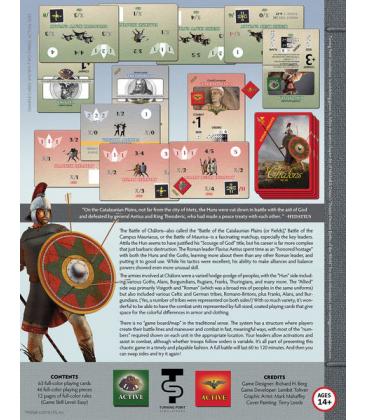Born half-Roman, but all business, this Battle saw "the Last Great Roman General", Aetius, at his finest! And finest would mean both political maneuvering with shifting alliances as well as tactical finesse.
The build-up to the Battle of Châlons (also called the "Battle of the Cataulnian Plains") is incredibly complex, and no one is certain which parts are actually true. Certainly much of the invasion of the Late Roman Empire were fierce peoples (Vandals, Goths, Alans, etc.) who were fleeing from the even-fiercer Huns. But Hunnish Leaders like Attila were far more than merely brutal, playing alliances, taking advantage of the deaths of neighboring Leaders, and playing both Eastern and Western Romans as clients and victims. The Roman Leader, Aetius, had Hunnish warriors fighting FOR him in earlier battles, and spent time with both the Huns and Goths as a honored hostage (learning much about both peoples while there). In fact, his father was a Roman General of Scythian origin, one of the original Groups of powerful Mounted Nomads, so you could say he was closer to his allies and adversaries than most Roman Commanders of the day, which is one reason he was one of the most influential men in the Western empire for over 20 years.
Attila had spent time visiting various parts of both East and West, but taken home more loot from the East and decided there must be riper pickings in the West. Adding much of Gaul to his Empire and plundering the rest looks to have been his aim, but his movements suggest as much opportunism as strategy.
The 2 Armies involved at Châlons were a varied hodge-podge of peoples, with the Hun side including various Goths, Alans, Burgundians, Rugians, Franks, Thuringians and many more. The Allied side was primarily Visigoth and Roman (which would be a broad mix of peoples in the same uniforms) but also included various Celtic and German Tribes, Romano-Britons and their own Allies of Franks, Alans and Burgundians.
Part of the TPS "Decisive Battles" Series. That means straightforward rules, key insights into the history behind the game, and designs aimed at one-session conclusions and high replay value.
Contents: 63 full-color Playing Cards, 46 full-color Playing Pieces, 12 pages of full-color Rules.
Página del Juego en la BGG

 2
2
 60-120 min
60-120 min






 14+
14+

